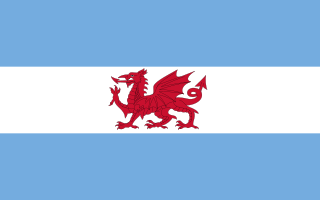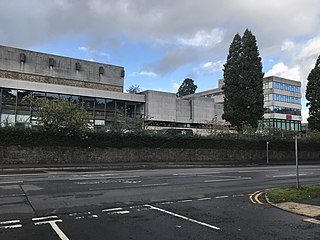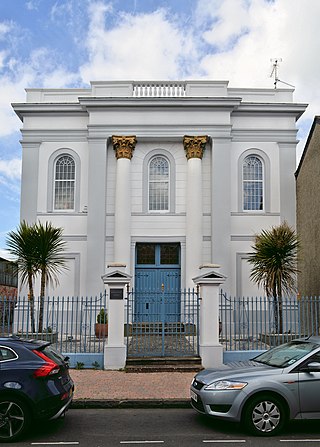Related Research Articles

Y Wladfa, also occasionally Y Wladychfa Gymreig, refers to the establishment of settlements by Welsh immigrants in Patagonia, beginning in 1865, mainly along the coast of the lower Chubut Valley. In 1881, the area became part of the Chubut National Territory of Argentina which, in 1955, became Chubut Province.

Rhondda Cynon Taf is a county borough in the south-east of Wales. It consists of five valleys: the Rhondda Fawr, Rhondda Fach, Cynon, Taff and Ely valleys, plus a number of towns and villages away from the valleys. Results from the 2011 census showed 19.1% of its 234,410 residents self-identified as having some ability in the use of the Welsh language. The county borough borders Merthyr Tydfil County Borough and Caerphilly County Borough to the east, Cardiff and the Vale of Glamorgan to the south, Bridgend County Borough and Neath Port Talbot to the west and Powys to the north. Its principal towns are - Aberdare, Llantrisant with Talbot Green and Pontypridd, with other key settlements/towns being - Maerdy, Ferndale, Hirwaun, Llanharan, Mountain Ash, Porth, Tonypandy, Tonyrefail and Treorchy.

Cathays Park or Cardiff Civic Centre is a civic centre area in the city centre of Cardiff, the capital city of Wales, consisting of a number of early 20th century buildings and a central park area, Alexandra Gardens. It includes Edwardian buildings such as the Temple of Peace, City Hall, the National Museum and Gallery of Wales and several buildings belonging to the Cardiff University campus. It also includes Cardiff Crown Court, the administrative headquarters of the Welsh Government, and the more modern Cardiff Central police station. The Pevsner architectural guide to the historic county of Glamorgan judges Cathays Park to be "the finest civic centre in the British Isles". The area falls within the Cathays electoral ward.

Llannerch-y-medd, is a small village, community and post town on the Isle of Anglesey in Wales. The Royal Mail postcode is LL71, and it has a population of 1,360, of whom more than 70% is Welsh speaking.

Taff-Ely was a local government district with borough status in Wales from 1974 to 1996.

Rhondda was a local government district in the geographical area of the Rhondda Valley, south Wales, from 1877 until 1996, with various statuses through its history.
This article is about the particular significance of the year 1968 to Wales and its people.
This article is about the particular significance of the year 1893 to Wales and its people.
This article is about the particular significance of the year 1890 to Wales and its people.

Boncath is a village, community and postal district in north Pembrokeshire, Wales, about 5 miles (8.0 km) west of Newcastle Emlyn.

Broadcasting House was the headquarters of BBC Cymru Wales' radio, television and online services, situated in north Cardiff. The purpose-built facility opened in 1966 and consists of three blocks containing studios, offices and technical facilities. In 2020 the BBC moved out, transferring to BBC Cymru Wales New Broadcasting House in Central Square, Cardiff. The building was demolished in 2021 to 2022, with the site to be used for housing.

Architecture in Cardiff, the capital city of Wales, dates from Norman times to the present day. Its urban fabric is largely Victorian and later, reflecting Cardiff's rise to prosperity as a major coal port in the 19th century. No single building style is associated with Cardiff, but the city centre retains several 19th and early 20th century shopping arcades.
This article is about the particular significance of the year 2010 to Wales and its people.

Percy Thomas Partnership was the trading name of the award-winning British architectural practice established some time between 1965 and 1973 as the successor to a series of earlier partnerships originally set up by Percy Thomas (1883–1969) in Cardiff, Wales in 1911/12. Percy Thomas and the Percy Thomas Partnership put their name to a number of landmark buildings in the United Kingdom including the Wales Millennium Centre, Cardiff. It opened offices overseas and completed a number of prestigious buildings in Hong Kong.

Glendower House, Glendower Street, Monmouth, Wales, is a Victorian former Congregational chapel constructed in a Classical style. The Royal Commission on the Ancient and Historical Monuments of Wales describes it as "a chapel of exceptional sophistication and elaboration of design and one of the earliest Italianate chapels in Wales". It is named after Prince Owain Glyndŵr.

The Gold Medal of the National Eisteddfod of Wales is awarded annually in three categories for excellence in Fine Art, Architecture, or Craft and Design.

Loyn & Co Architects is an architectural firm based in Penarth near Cardiff, Wales. It was founded by the architect Chris Loyn in 1987.

The Welsh Church of Central London, also known as The Welsh Baptist Chapel is a Welsh Baptist church in Eastcastle Street, in the City of Westminster, London, England. The church building is a grade II listed building with Historic England on the National Heritage List for England. It currently performs Baptist services bilingually in English and in Welsh as well as hosting concerts following a merger of the Welsh Baptist church with two nearby Independent churches in 2006.
Sarah Featherstone is a British architect.
Ivan Dale Owen was a Welsh architect in the modernist architectural style. The Glamorgan Archives and The Independent newspaper both described him as a 'leading figure in Welsh architecture'. He was a partner in the Percy Thomas Partnership before setting up his own architectural practice with his wife in Penarth in 1989. Among Owen's designs were BBC Broadcasting House, Cardiff, the entrance building and galleries of St Fagans National Museum of History, Cardiff, plus major developments at Cardiff University, Swansea University and Aberystwyth University.
References
- 1 2 "Building 3542". UK Modern House. Retrieved 12 January 2020.
- 1 2 John B. Hilling (15 August 2018). The Architecture of Wales: From the First to the Twenty-First Century. University of Wales Press. p. 238. ISBN 978-1-78683-285-6.
- ↑ "Danish-inspired pioneer of Welsh modernism Graham Brooks dies, aged 92". Architects' Journal. Archived from the original on 12 January 2021. Retrieved 12 January 2020.
- ↑ "Gold Medal for Architecture". National Eisteddfod of Wales. Archived from the original on 29 July 2014.
- ↑ Daily Mail (1968). 'Daily Mail' Book of Bungalow Plans. Daily Mail. p. 36. ISBN 978-0-85144-010-1.
- ↑ Alan Powers (2007). Britain. Reaktion Books. p. 161. ISBN 978-1-86189-281-2.
- ↑ "House in Llantrisant Road". Civic Trust Awards. Archived from the original on 12 January 2021. Retrieved 12 January 2020.
- ↑ Holland, Edward; Holder, Julian (March 2019). "Advice to Inform Post-War Listing in Wales" (PDF). Cadw. Archived (PDF) from the original on 7 November 2020. Retrieved 12 January 2020.